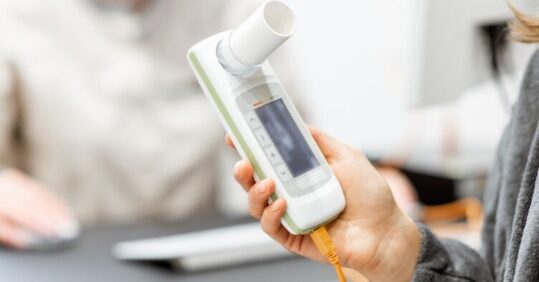Research update: What is the potential for AI to boost spirometry?

Lucille Kelsall-Knight reviews recent qualitative research that asked whether the use of AI could improve spirometry services
Spirometry services in England post-pandemic and the potential role of AI support software: a qualitative study of challenges and opportunities.1
Spirometry is a lung function test used routinely to diagnose and monitor chronic lung diseases.2 The NHS Long Term Plan3 identified quality and provision of spirometry in primary care as a priority, and its use is now restarting in England in the aftermath of the Covid-19 pandemic.
Related Article: Prescribing in England to be led by a single national formulary
However, the evidence regarding best practice of this intervention is limited.
The study by Doe and colleagues (2023)1 aimed to understand current provision of spirometry services in primary care and priorities for their future delivery, as well as stakeholder views on the potential to use AI in spirometry pathways.
The authors undertook semi-structured interviews with 28 key stakeholders involved in commissioning, service design and the implementation/delivery of spirometry services across primary care staff in England. The interviews took place between April and June 2022 and were conducted online or via telephone.
Following thematic analysis, four main themes were determined: historical challenges in the provision of spirometry services; inequity in post- pandemic provision of spirometry and challenges to restarting spirometry in primary care; future delivery closer to patients’ homes by appropriately trained staff; and the potential role of AI to support delivery.
The main limitation of the study was that, while the study team recognised that patients are key stakeholders in spirometry services, their perspectives were lacking in this research. However, the authors do plan to include patient perspectives in the next stage of this study.
Overall, this study highlighted that AI may have a role to play in supporting spirometry pathways, particularly if it proves able to improve quality assurance and interpretation of results, reduce workload and be trusted by clinicians.
Related Article: Advice on Guillain-Barré risk for adult RSV vaccine updated by MHRA
References
1 Doe G et al. Spirometry services in England post-pandemic and the potential role of AI support software: a qualitative study of challenges and opportunities. BJGP 30 October 2023; BJGP.2022.0608. DOI: 10.3399/BJGP.2022.0608
2 Levy M et al. Diagnostic spirometry in primary care: proposed standards for general practice compliant with American Thoracic Society and European Respiratory Society recommendations. Prim Care Respir J 2009; 18(3): 130–147.
3 NHS England. The NHS Long Term Plan. 2019.longtermplan.nhs.uk.
Related Article: Quick quiz: Management of COPD
Lucille Kelsall-Knight is a lecturer in children’s nursing at University of Birmingham School of Nursing

See how our symptom tool can help you make better sense of patient presentations
Click here to search a symptom




